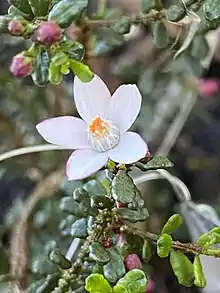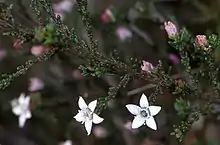| Narrow-leaf wax-flower | |
|---|---|
 | |
| Philotheca angustifolia subsp. montana in the ANBG | |
| Scientific classification | |
| Kingdom: | Plantae |
| Clade: | Tracheophytes |
| Clade: | Angiosperms |
| Clade: | Eudicots |
| Clade: | Rosids |
| Order: | Sapindales |
| Family: | Rutaceae |
| Genus: | Philotheca |
| Species: | P. angustifolia |
| Binomial name | |
| Philotheca angustifolia (Paul G.Wilson) Paul G.Wilson[1] | |
| Synonyms[1] | |
| |

Philotheca angustifolia, commonly known as narrow-leaf wax flower,[2] is a species of flowering plant in the family Rutaceae and is endemic to south-eastern Australia. It is a shrub with small leaves and white flowers with five egg-shaped petals in spring.
Description
Philotheca angustifolia is a shrub that grows to a height of 0.3–2 m (1 ft 0 in – 6 ft 7 in) with its stems covered with warty glands and a few hairs in grooves between the leaf axils. The leaves are cylindrical to club-shaped or egg-shaped, sessile, glandular-warty, 2–10 mm (0.079–0.394 in) long and 1–2 mm (0.039–0.079 in) wide. The flowers are borne singly or in groups of up to four on the ends of the branchlets, each flower on a pedicel 0.5–4 mm (0.020–0.157 in) long. There are five triangular sepals about 1 mm (0.039 in) long and five egg-shaped white petals 5–8 mm (0.20–0.31 in) long, usually with a pink midline. There are ten stamens each with a small white appendage on the anther, the stamens nearer the sepals with an awl-shaped tip.[2][3][4]
Taxonomy and naming
Narrow-leaf wax flower was first formally described in 1970 by Paul Wilson who gave it the name Eriostemon angustifolius and published the description in the journal Nuytsia. The type specimen was collected in the lower Mount Lofty Ranges by Darrell Kraehenbuehl.[5][6] In 1998 Wilson transferred the species to the genus Philotheca as P. angustifolia.[7]
In 1970, Wilson described also described two subspecies of Eriostemon angustifolius, subspecies angustifolius and subspecies montanus. The subspecies were also transferred to Philotheca and the names have been accepted by the Australian Plant Census:
- Philotheca angustifolia subsp. angustifolia[8] has cylindrical or club-shaped leaves 2–10 mm (0.079–0.394 in) long and less than 1 mm (0.039 in) wide;[6]
- Philotheca angustifolia subsp. montana[9] has egg-shaped leaves with the narrower end towards the base and about 4 mm (0.16 in) long and 2 mm (0.079 in) wide.[6]
Distribution and habitat
Narrow-leaf wax flower grows in open woodland and mallee. Subspecies angustifolia occurs in central Victoria and in south-eastern South Australia. There is a single record from 1882 in southern New South Wales. Subspecies montana only occurs in mountainous areas in western Victoria.[3][4][10][11]
References
- 1 2 "Philotheca angustifolia". Australian Plant Census. Retrieved 4 May 2019.
- 1 2 Kodela, Phillip; Bolton, Peri E. "Philotheca angustifolia". Australian Biological Resources Study, Department of the Environment and Energy, Canberra. Retrieved 4 May 2019.
- 1 2 Weston, Peter H.; Harden, Gwen J. "Philotheca angustifolia". Royal Botanic Garden Sydney. Retrieved 4 May 2019.
- 1 2 Bayly, Mike J. "Philotheca angustifolia". Royal Botanic Gardens Sydney. Retrieved 4 May 2019.
- ↑ "Eriostemon angustifolius". APNI. Retrieved 4 May 2019.
- 1 2 3 Wilson, Paul G. (1970). "A taxonomic review of the genera Crowea, Eriostemon and Phebalium (Rutaceae)". Nuytsia. 1 (1): 31–32. Retrieved 4 May 2019.
- ↑ "Philotheca angustifolia". APNI. Retrieved 4 May 2019.
- ↑ "Philotheca angustifolia subsp. angustifolia". Australian Plant Census. Retrieved 4 May 2019.
- ↑ "Philotheca angustifolia subsp. montana". Australian Plant Census. Retrieved 4 May 2019.
- ↑ Bayly, Mike J. "Philotheca angustifolia subsp. angustifolia". Royal Botanic Gardens Victoria. Retrieved 4 May 2019.
- ↑ Bayly, Mike J. "Philotheca angustifolia subsp. montana". Royal Botanic Gardens Victoria. Retrieved 4 May 2019.